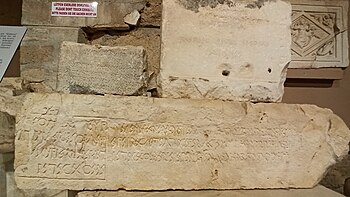Sidetic language
| Sidetic | |
|---|---|
| Region | Ancient southwestern Anatolia |
| Extinct | after the third century BCE |
Early forms |
|
| Sidetic script | |
| Language codes | |
| ISO 639-3 | xsd |
xsd |
|
| Glottolog | side1240 |
The Sidetic language is a member of the extinct Anatolian branch of the Indo-European language family known from legends of coins dating to the period of approximately the 5th to 3rd centuries BCE found in Side at the Pamphylian coast, and two Greek–Sidetic bilingual inscriptions from the 3rd and 2nd centuries BCE respectively. The Greek historian Arrian in his Anabasis Alexandri (mid-2nd century CE) mentions the existence of a peculiar indigenous language in the city of Side. Sidetic was probably closely related to Lydian, Carian and Lycian.
The Sidetic script is an alphabet of the Anatolian group. It has about 25 letters, only a few of which are clearly derived from Greek. Consensus is growing that the script has essentially been deciphered.
Evidence
Inscriptions and coins

Coins from Side were first discovered in the 19th century, which bore legends in a then-unknown script. In 1914, an altar came to light in Side with a Greek inscription and a Sidetic one, but the latter could not be deciphered. It was only after the discovery of a second Greek-Sidetic bilingual inscription in 1949, that Hellmut Theodor Bossert was able to identify 14 letters of the Sidetic script using the two bilinguals. In 1964 a large stone block was unearthed near the east gate of Side, with two longer Sidetic texts, including loan words from Greek (istratag from στρατηγός, 'commander' and anathema- from ἀνάθημα, 'votive offering'). In 1972, a text was found outside Side for the first time, at the neighbouring town of Lyrbe-Seleukia. Currently, eleven Sidetic coins and several coins with Sidetic legends are known.